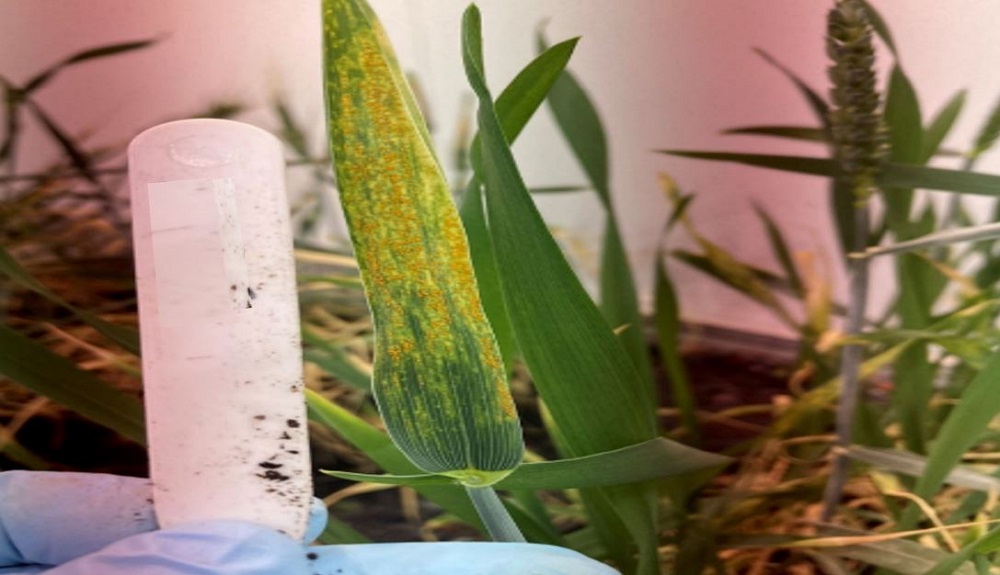Rusts in winter wheat: UKCPVS update and new AHDB watch lists
Thursday, 25 January 2024
The UK Cereal Pathogen Virulence Survey (UKCPVS) has delivered its annual update. Catherine Harries, a senior crop protection scientist at AHDB, outlines the main developments for rusts in winter wheat and examines what the latest watch lists reveal.
Winter wheat yellow and brown rust pathogen populations are dynamic, diverse and difficult to keep track of. Against this backdrop, the UKCPVS has a tough challenge to make sense of a shifting picture.
The survey screens rust isolates on Recommended Lists (RL) winter wheat varieties. The work builds an understanding of population shifts and the potential ramifications to varietal disease resistance.
Yellow rust in winter wheat
Last year was more of a septoria year than a yellow rust year, which was reflected in the number of samples received by UKCPVS – just 92. The most sampled variety was KWS Extase.
In this relatively small pool of samples, three new pathotypes were discovered (based on their ability to cause disease in a test set of varieties). It may sound like a lot. However, with the yellow rust population diverse, it isn’t unusual.
Adult plant resistance
The five most interesting isolates collected in 2022 were tested against adult wheat plants in 2023.
For the top five widely grown varieties – KWS Dawsum (9), KWS Extase (7), Champion (8), Skyfall (3) and Crusoe (8) – the percentage of plant infection with yellow rust was generally in line with RL 2024/25 disease ratings (shown in brackets).
However, KWS Extase showed relatively high levels of infection (note: the variety lost one disease rating point in RL 2024/25, moving from an 8 to a 7). Skyfall was relatively susceptible to all five isolates, which isn’t unexpected for a variety with a disease rating of 3.
Although varieties generally performed as expected in RL trials in 2023, it is important to expect the unexpected.
KWS Zealum (9) has been highlighted in our updated yellow rust watch list (based on four trials), with lower-than-average performance at some sites (in Northumberland and Scotland). The list also highlights LG Astronomer (8), KWS Brium (9) and Crusoe (8) as ones to watch.
Access the yellow rust watch list
What is a 'watch list'?
Introduced for RL 2021/22, the watch list provides a way to flag unusual levels of rust seen in some trials, compared with what the headline disease rating would otherwise suggest. This extra layer of information may provide a valuable early warning of a potential change in the UK’s pathogen population and help focus in-season management strategies.
Young plant resistance
The latest screening results at the young plant stage detected susceptibility to yellow rust in three varieties listed as resistant at this stage in the current RL (2024/25) – RGT Bairstow (8), RGT Rashid (8) and KWS Zealum (9).
As yellow rust starts to take hold this spring, please bear this mind. However, these varieties have good resistance at the adult plant stage, which should help them ‘shake off’ early infection. The good news is that over half of the varieties in RL 2024/25 are classified as resistant to yellow rust at this early stage.
Genotype data
The above screens classify yellow rust isolates according to infection patterns in varietal screens (the pathotypes). However, UKCPVS also examines the genetic patterns in the yellow rust population (the genotypes), which are classified using colours.
The UK yellow rust population is dominated by the red group, with occasional appearances from the pink and purple groups, and 2023 was no different. This situation is mirrored in Europe.
Brown rust in winter wheat
The UKCPVS received 15 brown rust samples in 2023, with five new pathotypes identified.
Recently, the biggest change has been a sharp increase in the ability of pathogens to overcome the brown rust resistance gene Lr24. In fact, 40% of isolates tested could unlock this resistance gene in 2023. It is believed that Theodore (no longer listed) carries Lr24 – and we’ve seen more brown rust on this variety since 2022.
In adult plant tests, no varieties were completely resistant to any of the isolates. However, KWS Dawsum (7), LG Astronomer (7) and Skyfall (9) all had less than 5% brown rust.
Once again, varieties generally performed as expected in RL trials in 2023. However, the brown rust watch list highlights KWS Zyatt (7), LG Astronomer (7) and KWS Extase (6) as varieties that performed slightly worse than expected (at 1–3 sites).
Access the brown rust watch list
All but one variety, RGT Goldfinch (an RL candidate), were susceptible to brown rust at the young plant stage.
 NIAB
NIAB
Changing UKCPVS
The team behind UKCPVS at NIAB is working hard to make its outputs more applicable to farmers.
They aim to test isolates collected in 2024 on all recommended and candidate varieties at the young plant stage. They will do this rapidly, so the results can be included in the next RL edition (2025/26). To achieve this, the team will not conduct adult plant trials. UKCPVS also plans to release more information on the samples received during the season.
AHDB continuously reviews its research portfolio to ensure that it delivers the best value to levy payers. If you have opinions on the UKCPVS project, positive or negative, or would like to suggest ways that it could be improved or the impact on you should AHDB cease investment in it, please get in touch with me: catherine.harries@ahdb.org.uk
Further information
This update is based on UKCPVS results presented at the annual stakeholder event, which took place on 16 January 2024. It included several other talks, with the presentations and videos below.
Access further information on the UKCPVS web page: ahdb.org.uk/ukcpvs
Save the date
The next UKCPVS event will take place on 13 January 2025.
Watch the presentations
UKCPVS reports from the 2023 season
Charlotte Nellist, Amelia Hubbard (NIAB/UKCPVS)
The Yellowhammer project
Lesley Boyd (NIAB)
Use of resistant varieties is a key component of the integrated pest management (IPM) of yellow rust in winter wheat.
However, new variants of the pathogen are discovered almost every year in the UK, with new virulences and new virulence combinations helping the pathogen to break down varietal resistance.
This presentation outlined findings from the yellowhammer project (2018–23) that aimed to provide comprehensive knowledge of the disease resistance present in UK and northern European wheat germplasms and information on the sources of resistance that are effective against current populations.
The work is helping wheat breeders deploy yellow rust resistance genes in new wheat varieties and improve the overall durability of resistance.
How agronomists use the UKCPVS
Todd Jex (Agrii)
Agronomists need to consider many factors when deciding how to tackle yellow rust. This presentation examined how an agronomist approaches decision making when confronted with multiple agronomic challenges.
In particular, the presentation explored the use of varietal resistance, chemical control and non-chemical approaches. It also discussed the importance of good data, including the role of the UKCPVS.
Monitoring Irish Zymoseptoria tritici population for virulence to septoria tritici blotch resistance
Steven Kildea (Teagasc)
Following high levels of septoria tritici in the 2020/21 growing season, there were concerns that the pathogen population was able to break certain resistance genes for this economically important foliar disease of winter wheat.
Unexpected levels of septoria tritici infection were first reported on the winter wheat variety Cougar in 2015. However, the breakdown in resistance appears to have been limited to that specific variety and varieties with Cougar in their parentages.
This presentation outlined the situation in the Irish Zymoseptoria tritici population, which has much in common with the UK experience.



